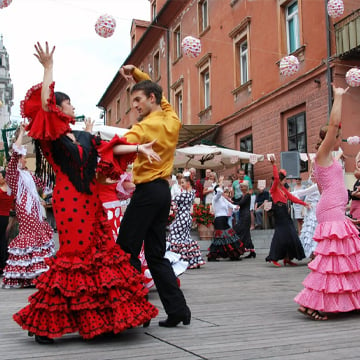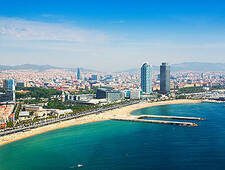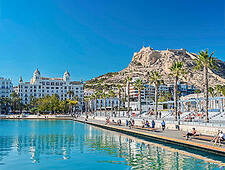Spain is a diverse and vibrant country, made even more interesting by its unique system of autonomous communities. Each of these autonomous regions of Spain has its own culture, language, and government, offering expats a chance to explore different lifestyles, customs, and ways of life all within one country. Whether you're looking to settle in Andalusia, the Balearic Islands, or Murcia, this guide will help you navigate the intricacies of Spain’s decentralised system and assist you in choosing the best region for your needs.
Understanding Spain’s Autonomous Regions: A Brief Introduction
Spain, often known as the "Estado de las Autonomías," is a regionalized state. According to Article 137 of the Constitution, it is composed of three levels of government. These are; central, regional, and local (which includes provinces and municipalities). Since these levels are not hierarchical, none is superior to the others; rather, their jurisdictional abilities define them independently. These autonomous communities have varying degrees of legislative autonomy. The government is led by a Prime Minister (Presidente del Gobierno) although the Head of State is the Monarch. The Spanish delegation allows Autonomous Communities to take part in EU decision-making..jpg)
The basic political institutions of each community are similar to those of the country as a whole. Each has a unicameral legislature elected by universal adult suffrage and an executive consisting of a president and a Council of Government responsible to that legislature.
How many autonomous communities are there in Spain?
There are 17 autonomous communities in total, 50 provinces and 8.131 municipalities. Each autonomous community has its own government, legislature, and official language. Additionally, two autonomous cities—Ceuta and Melilla—are located on the northern coast of Africa. These regions are the heart of Spain’s decentralisation, and understanding how they operate is key to navigating both the bureaucracy and day-to-day life as an expat. The constitution declares that Spain is a constitutional monarchy and advocates the essential values of freedom, justice, equality, and political pluralism. It also provides for the separation of powers into executive, legislative, and judicial branches.
Below is a list of all the autonomous areas of Spain and a brief description of what makes each one stand out:
1. Andalusia:
It is the second largest of the communities in terms of area of land and it’s capital is Sevilla. Andalusia is divided into 8 provinces and has 56 cities in total including Almería, Córdoba, Cádiz, Granada, Huelva, Jaén, Málaga and Sevilla. Best time to visit Andalusia is spring, which is ideal for pleasant temperatures and cultural festivals.
Best Places in Andalusia: Visit the historic Alhambra in Granada, the beaches of the Costa del Sol, and the vibrant city of Seville.
Real Estate: Discover the homes for sale in Andalusia and find your perfect home among the beautiful Andalusian countryside or in the heart of its metropolitan cities like Málaga, or Marbella.
2. Balearic Islands:
It’s capital city is Palma. Also consists of Menorca, Mallorca, Ibiza, Formentera and Cabrera. Catalan is the official language.
Best Places: World-renowned for Balearic Islands beaches with crystal-clear waters, scenic coastal views, nightclubs of Ibiza, and tranquil towns on Mallorca.
Real Estate: Explore property for sale in Balearic Islands for luxury homes or beachfront properties!
3. Murcia
Murcia has only one province which including the cities of Cartagena and the Murcia City (capital). Weather for Murcia Spain known for its hot, dry summers and mild winters, Murcia offers a Mediterranean climate.
Real Estate: Real estate for sale in Murcia offers affordable housing with access to stunning coastlines and golf courses.
Things to do: It is home to several prestigious golf course Murcia.
Accessibility: International Airport Murcia Spain connects you to major European cities.
4. Valencia: 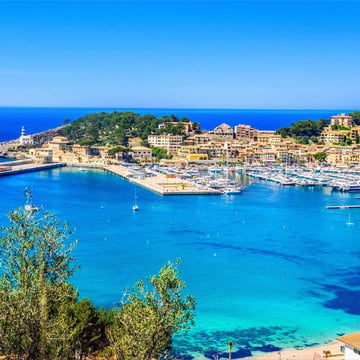
There are 3 provinces which include Valencia City, Alicante and Castellón. The capital city is Valencia city. The Valencian language has co-official status.
Real Estate: From modern apartments and traditional Spanish villas to luxurious houses for sale in Valencia Spain there’s something for everyone.
Accessibility: Valencia Airport is the major international gateway to the region. Alicante–Elche Miguel Hernández Airport, the 6th most popular airport in Spain, also serves as a frequently used airport.
Things to do: The best things to do in Valencia Spain is to relax on Mediterranean beaches, enjoy Valencia’s famous paella, visit the City of Arts and Sciences and the famous Valencia Cathedral and discover beautiful nature of Alicante.
5. Cataluña
It has 4 provinces of which Barcelona is the biggest in terms of population. Barcelona is known as the center of art, education and intellectual metropolitan life. The others include Girona, Lleida and Tarragona. Barcelona is the capital city. Beside Spanish, Catalan and Aranese are also recognised as official languages. Catalan language has over 8 million native speakers.
6. Castilla y León
Castilla and León is the largest of the 17 autonomous communities and includes 9 provinces. The capital is Valladolid. Official language is Spanish. It includes Salamanca, Palencia, León, Ávila and Valladolid cities.
Things to do: To visit famous cathedrals like Burgos Cathedral which is a UNESCO World Heritage Site.
7. La Rioja
It is one of the smallest communities since it has only one province. The capital is Logroño City. The official language is Spanish. There are more than 600 wineries in La Rioja. Vino tinto, or red wine, makes up the majority of its annual production of 250 million liters.
8. Las Islas Canarias
There are 2 provinces – Las Palmas and Santa Cruz de Tenerife. The islands include Tenerife, Gran Canaria, Fuerteventura, Lanzarote, La Palma, La Gomera and El Hierro. Capital status is shared between Santa Cruz de Tenerife and Las Palmas de Gran Canaria. The official language is Spanish.
Things to do: The second-largest Carnival celebration in the world takes place in Tenerife, one of the seven major islands in the Canary Islands.
9. Madrid
It is made up of one province, which is, of course, Madrid. Madrid is the capital of the autonomous community, the country and the province. The official language is Spanish.
Things to do: Attending dance shows to watch Flamenco, one of the traditional dances of Spain.
10. Aragon
Zaragoza is the capital city of Aragon and it is one of the oldest cities in the country established by the Romans. The official languages are Spanish, Aragonese and Catalan.
11. Extremadura
The capital city is Mérida. It is famous for the Augusta Emerita Roman remains. Extremadura is a remote region with mountains, forests, lakes, and reserves, including Cornalvo Natural Park and Monfragüe National Park, which are home to a variety of birds.
12. Navarre
The capital city is Pamplone. Navarra was a medieval Basque kingdom before. So, of the official languages is Basque beside Spanish.
13. Cantabria.jpg)
Cantabria is located in northern Spain. It is known for its stunning natural landscapes, which include rugged coastlines along the Bay of Biscay, green valleys. Santander, the region's capital, is a major port city with a rich maritime history and beautiful beaches.
Things to do: The region has a mild oceanic climate, making it ideal for outdoor activities such as hiking, surfing, and exploring the picturesque villages.
14. Galicia
The major cities are Ourense, Vigo, A Coruna and Lugo. Known for its dramatic coastline, Galicia is famous for its rías (coastal inlets), rugged cliffs, and numerous small islands. The region has a rich Celtic heritage, which is reflected in its music, festivals, and folklore. Official languages are Galician and Spanish.
15. Castilla-la Mancha
It known for its rich historical heritage, vast plains, windmills, which are famously immortalised in Don Quixote, the iconic novel by Cervantes. The capital, Toledo, is a UNESCO World Heritage site, renowned for its blend of Christian, Jewish, and Muslim cultural influences. Major cities are Ciudad Real, Albacete, and Toledo.
Best places: Toledo Cathedral which is a historical cathedral.
16. Asturias
The region is often referred to as Spain's green paradise due to its temperate, oceanic climate, which supports dense forests and rich biodiversity. The capital of Asturias is Oviedo, a historic city famous for its medieval architecture. Official languages are Asturian and Spanish.
Things to do: The region's rugged mountains make it a popular destination for outdoor activities like hiking, climbing, and skiing.
17. Basque Country
Known for its distinct culture, language (Basque or *Euskara*), and rich history, the region has a strong sense of identity. It has 3 provinces: Álava, Gipuzkoa, and Bizkaia, with the city of Vitoria-Gasteiz serving as the capital and Bilbao as the largest city.
Things to do: The region’s stunning landscapes include coastal cliffs, sandy beaches, and the green hills of the interior, making it a popular destination for outdoor activities such as surfing and hiking.
Melilla and Ceuta
They are both an autonomous city rather than community. Mellila is a tiny peninsula in the far northwest of the African continent. Ceuta is also in the North Africa. It is situated on the shores of the Strait of Gibraltar.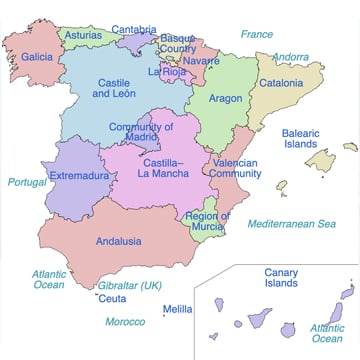
Bureaucracy and Administrative Processes
One of the most important aspects to understand as an expat is how bureaucracy works in Spain. While some matters are handled by the central government, many are the responsibility of the autonomous administrations.
- Central Government: The central government is responsible for national matters like defence, foreign policy, and the legal system.
- Autonomous Administrations: Each autonomous community has control over regional issues such as education, health care, and regional planning. This means that laws and regulations can vary from region to region, which can be both an advantage and a challenge for newcomers.
For example, healthcare is managed by the region, meaning the quality and accessibility of services can differ depending on the community. Similarly, education systems may follow different curriculum, and the availability of certain public services or subsidies might vary.
How the autonomous system affect daily life?
Bureaucracy:
The division between central and regional authorities can sometimes lead to complex bureaucratic processes. Expats will often need to interact with both regional and national bodies to resolve issues like tax filings, residency permits, and driver’s license exchanges.
Healthcare: 
The health system is administered by the national Ministry of Health through a department known as the National Institute of Health (Insalud). However, as the system of regional autonomy developed, much of the responsibility for health care devolved to the regional governments. The system provides a full range of services in clinics and in general and specialised hospitals. Health care is not a government monopoly, though all but a very small percentage of the population goes to state-run clinics. Many doctors have their own clinics outside.
Education:
Education in Spain is also managed by regional governments. This means that school curriculums can vary, as can the language of instruction (e.g., Catalan in Catalonia, Basque in the Basque Country). Expats should research local educational systems when moving with children.
Transportation:
The transportation networks in Spain vary from region to region, with larger cities like Madrid and Barcelona having extensive metro systems. In rural areas, public transportation may be less frequent, and regional governments often provide services like buses or regional trains.
Culture: 
The cultural diversity of Spain’s autonomous regions is one of its most fascinating aspects. From the flamenco music and bullfighting traditions of Andalusia to the modernist architecture of Catalonia, the cultural practices of each region are shaped by its history, climate, and population. Learning about the local culture and integrating into your specific region can enhance your experience as an expat.
Languages
In all but six autonomous communities, Spanish is the only official language. In these communities, Spanish is co-official alongside other language. These are:
- Catalonia: Catalan and Occitan
- Balearic Islands: Catalan
- Navarre: Basque
- Valencian Community: Catalan (also called Valencian there)
- Galicia: Galician
- Basque Country: Basque
Consequently, Spain’s autonomous communities offer a rich and varied experience for expats. From the warm Mediterranean beaches of the Balearic Islands to the cultural treasures of Andalusia, each region is distinct, providing unique living environments and opportunities.

.jpg)
